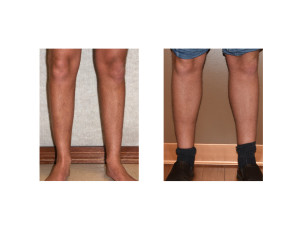
The following are the typical instructions for calf implant augmentation:
1. On discharge from the surgery center, go home directly to bed for the night. Get up only to go to the bathroom and keep the legs elevated as much as possible.
2. Calf implants are associated with a moderate amount of pain in the first few days after surgery. Narcotic pain medications are almost always needed and you should them as prescribed. In a few days or by a week after surgery, you may switch to Ibuprofen completely or alternate between doses with the narcotic medication.
3. There will be ace wraps placed around the calfs after surgery. This is in place for comfort only and does not play a role in maintaining the position of the implants. You may take these off the next day and they do not need to be put back on unless they feel better if they are worn.
4. The incisions behind the knees are covered with glued on tapes. This may be allowed to get wet while showering. They will be removed during your first postoperative visit. The sutures in the incisions are under the skin and do not need to be removed.
5. Swelling and tightness of the calfs is common and peaks by two to three days after surgery. Conversely, bruising is uncommon although possible.
6. You can’t walk around a lot nor walk up stairs at first when you have this type of implant. You MUST limit your walking or risk infection. You should also elevate your legs as much as possible for the first week and wear a type of support hose for 3 weeks. Normally, you may return to exercise and other activities after 6 weeks.
7. It may be helpful to wear hoes with 1 – 2” heels after surgery and for several weeks thereafter. This will cause the calf muscles to not be under too much stretch and the discomfort will be less.
8. Do not expose the calf or scars to the sun or tanning bed for at least 2 -3 weeks after the surgery as severe burns can occur from minimal exposure. Scars must be covered when exposed to sun or the tanning bed (so as not to hyperpigment) until all redness is gone which takes 3 to 6 months. You may use tanning creams.
9. The incision behind the knee will heal in about 10 days. However, it will remain red for up to 6 months until its color eventually fades and blends in better with the surrounding skin. A small fine-line scar will remain. The area surrounding the implants, however, will take about 6 weeks to fully heal. Therefore, you need to be careful with activities to avoid potential problems. Most complications occur in men who do not follow instructions well and insist on returning to work or the gym too early. This can result in hematoma (bleeding), excess swelling, or other problems.
10. If any redness, tenderness, or drainage develops on the chest or from the armpit incisions after the first week of surgery, call Dr. Eppley and have your pharmacy number ready.


